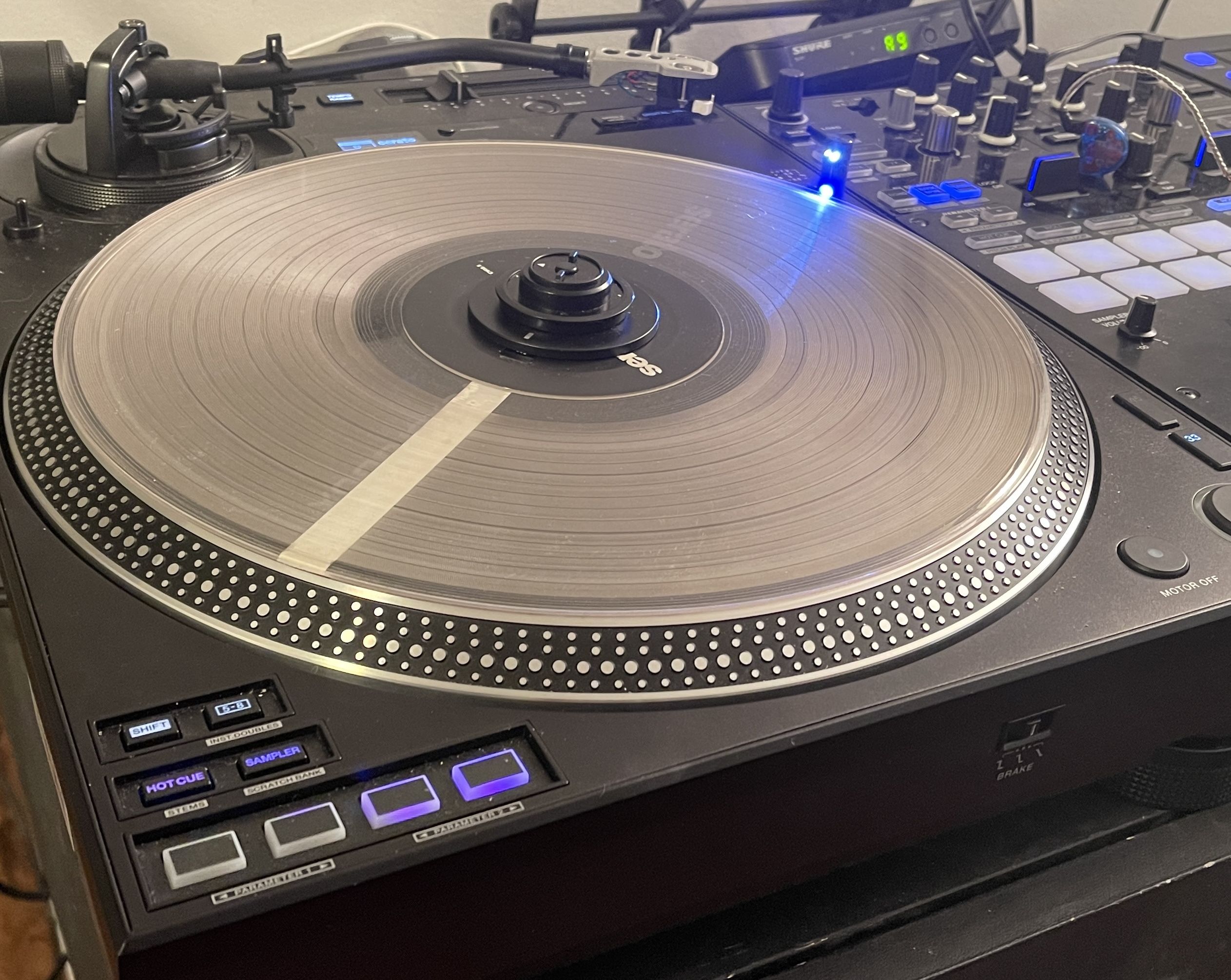Those madlads at Pioneer DJ (aka AlphaTheta) did it! After years of speculation, fan-made concept art, and wishful thinking, the company dropped the PLX-CRSS12 on the unsuspecting DJ community – and turntablists and hip-hop DJs collectively started salivating.
Finally, there’s a turntable capable of playing vinyl with built-in DVS control without the need for needles, 3rd party accessories, or commercially available mods. Now, the question is: does this $1,400 turntable actually live up to all the hype?
Let’s find out.
The concept
First, we’ll just put this out there: this is a turntable that also offers built-in, needleless turntable control over digital audio, which isn’t something brand new. The concept has existed for a while – companies like Gemini and Numark were offering turntable/CDJ hybrid devices in the late ’00s.
At its core, the PLX-CRSS12 isn’t all that removed from these hybrid turntables of yore. Pioneer DJ has modernized the concept to utilize DVS rather than to play CDs and created a wholly unique way to control the digital signal. With the touch of a button and the use of the unique Magvel Clamp, you can immediately flip from playing vinyl to outputting a timecode signal internally generated by the turntable.
Add in some robust MIDI controls, an incredibly well-tuned platter/motor, and fun features like Step Pitch, and you have an absolute beast of a turntable.
How the PLX-CRSS12 works
At its core, the turntable uses the same locking spindle mechanism to control digital transport that has been around since the 2000s. This is conceptually the same technology found in the Rane Twelves and One, and goes as far back as the Denon DN-S5000 back in 2002.
Where Pioneer DJ truly innovates is in how the locking mechanism works. Other companies historically use adapters that need to be bolted onto specific vinyl plates – most require the adaptor to be connected via a screw (and later, the quick-release adapter). With the PLX-CRSS12, Pioneer DJ has introduced the Magvel Clamp as their own innovative solution.
The Magvel Clamp
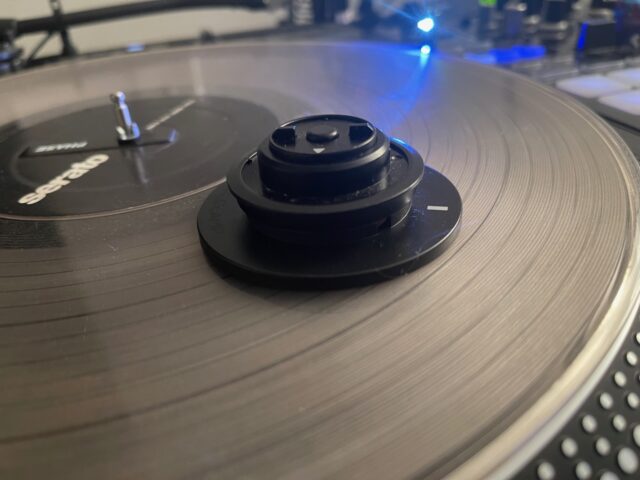
Resembling a vinyl weight, the Magvel Clamp is the mechanism used to attach the record to the spindle allowing for transport control in Serato or Rekordbox. The practical application is that you can use any record – or even the slipmat – to control your timecode. One of my favourite features of the Magvel Clamp is the ability to adjust the tension of the clamp – allowing you to adjust how “slippy” the record feels on the platter.
I have no doubt that scratching with the slipmat will be the new novelty of this deck – comparable to all the DJs scratching with the record off the player using the Phase.
Unlike the modern controllers like the Rane Twelves or even Pioneer DJ’s own DDJ-REV7, the PLX-CRSS12 has stuck with the tried-and-true timecode signal vs the high-resolution MIDI options of modern spinning platter players.
Layout
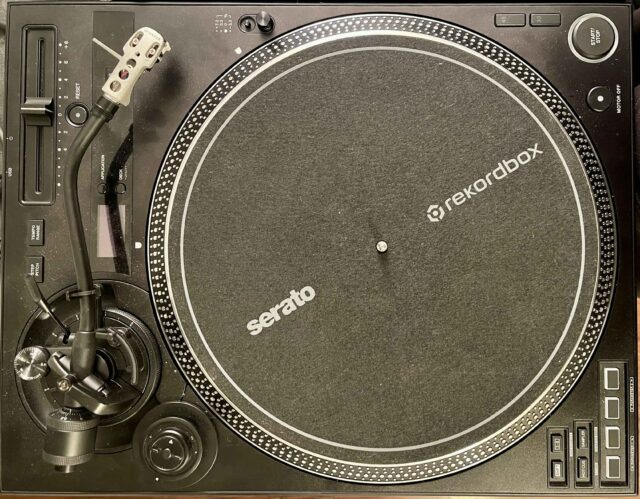
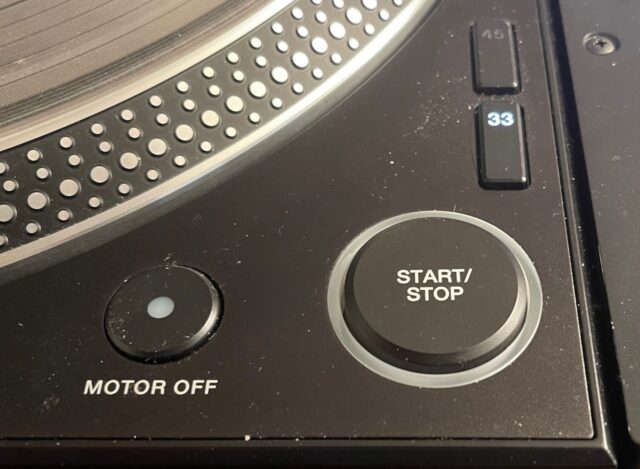
If you’re reading this, you’ve probably used a turntable before and are well-versed with its typical layout. With the PLX-CRSS12, everything is where you would expect in terms of the standard components (tonearm, pitch fader w/ ultrapitch, start/stop, etc).
As for traditional controls, the 33/45 buttons are the only non-standard aspect since the numbers are printed with battle style in mind.
Controls
The additional controls are subtly placed and fairly unintrusive. The main performance controls are located on the lower left side (given battle mode) – bringing back memories of the old Novation Dicers. The four main buttons can be used for four separate features: Hot Cues, Stems, Sampler, and Scratch Bank. Two buttons control which page to use allowing you to cycle through two pages each. An additional Shift button allows you to access an additional two custom mappable pages of controls.
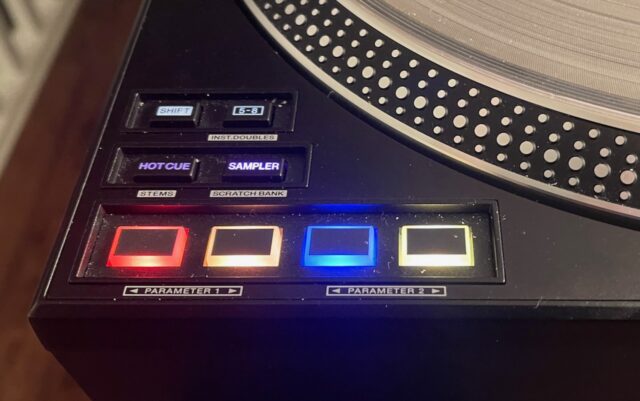
The additional controls are subtly placed and fairly unintrusive. The main performance controls are located on the lower left side (given battle mode) – bringing back memories of the old Novation Dicers. The four main buttons can be used for four separate features: Hot Cues, Stems, Sampler, and Scratch Bank. Two buttons control which page to use allowing you to cycle through two pages each. An additional Shift button allows you to access an additional two custom mappable pages of controls.
The performance controls might be a little redundant for a lot of DJs though. The majority of DJs interested in the CRSS12 likely use a DVS mixer like the DJM-S11, which gives you all the controls you could ever hope for. That said, it’s nice to have a dedicated set of buttons for features like Stems or Scratch Bank – allowing you to reduce the amount of page switching on your main mixer pads.
The remaining controls give you access to utility-based features on the turntable – including a button to switch between vinyl and timecode mode, a button to switch which software deck you want to control in your software, and an Application button that switches the timecode signal from Serato to Rekordbox. These controls are a little less conveniently placed as they – and a small screen – are located under the tone arm when docked in the cradle. Most users will likely only set these controls once, though, so this isn’t a huge huge drawback.
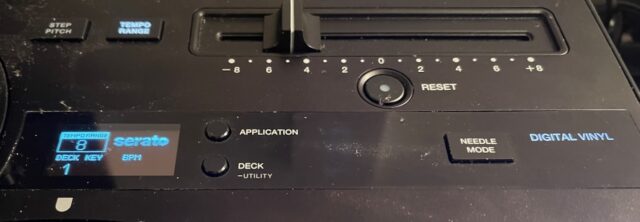
In addition, long-pressing the Deck button gives you access to the Utility screen and provide you with the ability to customise some features like the the deck Torque (low, medium, or high), the LCD brightness, the ability to turn on and off the deck standby, and the option to factory reset the deck.
Overall, the controls are a welcome addition to the deck, although I did find the buttons a little small and cramped. I feel like the layout on the Reloop 8000 MK2s are slightly more usable overall – but that comes with the caveat that they are also much more in-your-face.
Step Pitch
Step Pitch is a brand new feature that allows you to use the pitch fader to adjust the pitch of the record by semitones. Reminiscent of the Reloop 8000 MK2’s Platter Play mode.
While I’m sure some creative turntablist will find some interesting uses for this feature, I didn’t find it particularly different from just adjusting the pitch. The Reloop’s Platter Play is much more robust – allowing you to set scales, change root notes – and playing pitches on the pads is much more conducive to creating a musical result to me than moving the pitch fader around.
Build
The PLX-CRSS12 is based on a heavily-modified Hanpin Super OEM chassis, which has been very proven in the field over the last few decades. That said, not all Super OEM decks are created equal as everything from the housing to the motor can be customised to the parameters of the company-designed deck.
The overall build of the CRSS12 feels excellent, featuring high-quality plastic casing and a metal top faceplate. Weighing in at nearly 27 lbs, it’s in-line with the majority of Super OEM decks (except the old Stanton ST150s, which weighed a ridiculous 36 lbs). This definitely gives the turntable a sturdy and premium feel.
Obviously, I cannot speak for longevity on this deck as I’ve only used it for a couple of months, but nothing about the deck feels cheap or questionable. It’s a solid piece of engineering and manufacturing that feels incredibly well put together and at this point, the Hanpin engineering and manufacturing pedigree has been well proven in the field.
Connectivity

In addition to the standard RCA ports, Pioneer DJ has again opted to maintain a separate grounding cable instead of internally grounding the deck like a lot of modern options. The grounding is removable and replaceable – unlike Technics of old, which require opening up the deck to replace the grounding wire.
In terms of connecting to a PC, Pioneer DJ continues the push to using USB-C as the new standard of USB as well.
The timecode signal is outputted at the phono level, so there’s no need to switch out anything on your mixer or box in order to swap between timecode and vinyl.
Compatibility
The PLX-CRSS12 is compatible with both Serato and Rekordbox as it provides both types of timecode signal. While Serato is still the overwhelming choice among DJs who use DVS, having the option for Rekordbox is a welcome addition – especially considering neither the DDJ-REV7 or the DJM-S5 had Rekordbox support initially (although the REV7 just received an update with Rekordbox support).
Things We Loved
The Magvel Clamp

This is a pretty brilliant design. Between this and the REV7 platters, Pioneer DJ has taken something that hasn’t seen any huge changes in decades and innovated some amazing solutions. It’s easily the most elegant iteration of the tried-and-true locking spindle technology I’ve ever seen. The ability to use any record – and even the slipmats – without having to add stickers or drill holes is a revelation. Add in the tension adjust and you have the best implementation of a digital turntable control system since DVS first came out.
On top of that, the Magvel Clamps functions as a proper vinyl clamp, allowing you to smooth out warped and bowled records with the tension adjust.
The look
I often find some of Pioneer DJ’s styling choices to be a bit gaudy. I’ve never been a fan of the polished plates used in some of their mixers. The DDJ-S11 styling around the screen honestly reminds me of a concept race car designed by a 12 year old, and the Opus 1 is… unique.
That said: they’ve nailed it with the PLX-CRSS12. It maintains a classic look highly reminiscent of the iconic Technics 1200, with just enough modern elements to give it a sleek-yet-timeless appeal. The extra buttons and controls are subtle enough that they don’t scream “look at me!”, and the screen displays minimal information rather than overloading you with too much.
The feel
As someone who has been scratching at a fairly decent level for the last while, the feel of actually using the decks is fantastic. Super OEM decks in general have become the deck of choice for modern turntablists due to high torque, responsiveness, and ultra-pitch options, and Pioneer DJ has customised the torque and feel based on feedback from high-level and world champion scratch DJs.
The high torque setting is modelled after the specs of the old Vestax PDX2000 – which is one of the most highly sought-after turntables among the tablist circles due to its motor feel. The mid torque setting is modelled after the Technics 1200 motors. The low torque setting is… low? I didn’t use it for very long because I’m really not sure who would prefer a low torque deck. I’m sure some vinyl nerd can explain to me the benefits in the comments.
Use of the official Serato Noisemap timecode
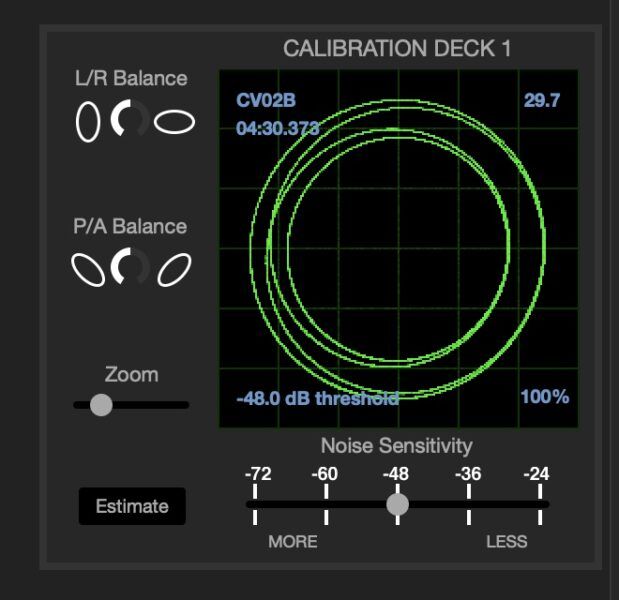
One of the big things about the Serato timecode tone is its use of a proprietary layer of noise over the 1k sine wave. Dubbed the Serato Noisemap, this was developed way back in the Scratch Live days to allow for better tracking and also allow for some unique features on the software (needle drop, drop to cue, sticker lock).
While most of those features are unavailable using the built-in timecode, the benefits are very apparent in the tightness of the tracking. Anyone who has used the timecode version of Phase is familiar with the amount of sticker drift apparent in non-proprietary timecode signals.
Things That Need Improvement
No MIDI/HID
I feel like a minority here, but I much prefer the high-resolution MIDI control for platters like that found on the REV7 or the Rane Twelves for a multitude of reasons. While I do find timecode a little tighter for scratching (which is apparently why Pioneer DJ chose to go with timecode), I prefer the controller-style perks that come with MIDI platters including things like instantaneous pitch, being able to record stop with Pitch n Time on, and auto-sync for instant doubles to name a few. I would have loved to see the option to choose either MIDI or timecode like you can in the Rane Twelve MK2s
A high pricetag: $1,400 per deck
Priced at a whopping $1,399 USD per deck, this is the most expensive DJ-centric turntable ever made – beating out the $1,200 Technics 1200 MK7. While the functionality of the PLX-CRSS12 is lightyears beyond the Technics 1200 MK7, that pricetag was already considered pretty outrageous when it came out. Here in Canada, a pair of these decks will cost me $4,000 after taxes.
Yes, this is a premium product with a lot of cutting-edge technology – but it comes in at more than double the price of a standard turntable like an Audio Technica AT-LP1240 ($500 USD), or even a turntable with advanced controls like the Reloop 8000 MK2 ($800 USD).
Doubled up MIDI CCs in Serato
I’ve found that the 2nd custom MIDI page on the CRSS12s uses the same MIDI CCs as the Scratch Bank controls on the DJM S7. This means mapping anything to the controls overwrites the Scratch Bank controls on the mixer.
Considering that the PLX-CRSS12 already has built in Scratch Bank controls, it’s especially puzzling that this slipped through. Unfortunately, I don’t have a DJM-S11 on hand to see if there are MIDI conflicts with that mixer, but considering the increased complexity of the S11, I could see some more potential overlap.
When testing on my Rane Seventy-Two, I did not encounter any MIDI conflicts.
Limited space under the deck
I’m used to using my trusty Technics 1200 M3Ds or my Rane Twelve MK2s, where there is a certain amount of clearance underneath the deck. This allows for an easy place to tuck cables and laptop stands in a cleaner, more presentable manner. The CRSS12s do not offer much room under the decks and as a result, I was finding it challenging to be able to place my laptop stand and still have room for my cables.
The proprietary Magvel Clamp
While the Magvel Clamp is an extraordinary feat of design and innovation, much like the REV7, this proprietary technology comes with some drawbacks – the main one being the potential scarcity of parts. With reports that replacement discs for the REV7 taking months to deliver, the Magvel Clamp could easily fall to that same fate if shortage woes persist.
Even without issues with shortages, losing or breaking a clamp does require finding a replacement part in due time. That said, the Magvel Clamp is currently being sold separately in stores (unlike the platters for the REV7).
Of course, unlike a player like the REV7 or Rane Twelve, you can always go back to using a needle until your replacement arrives.
You can even use the Rane adaptors on the deck in a pinch so if you also own Rane Twelves or a Rane One, the adapter snaps right onto the spindle.
Final Thoughts
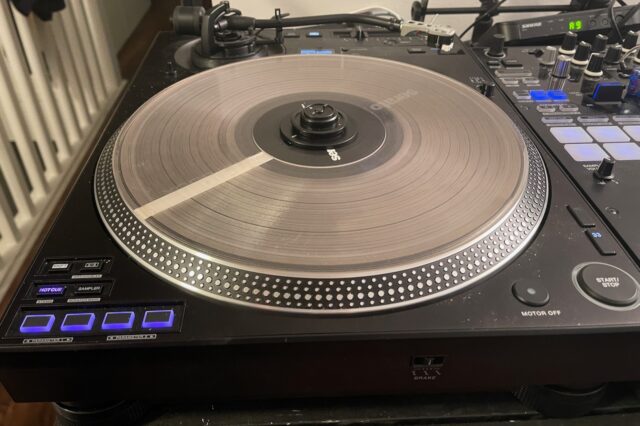
This is probably the finest turntable right now for a DJ – full stop. I hate to pull out some corporate buzzwords, but the synergy in the design is sublime. The CRSS12 provides the benefits of needle-less platter control, plus a fully functional turntable, and combines with the elegant Magvel Clamp mechanism to create an amazing deck that could well be the last turntable you ever need to buy.
There are some drawbacks; the lack of a MIDI platter option will always be a sore point for me, and there are a few minor gripes about some design choices that are little more than nitpicks. But when held up against the current lineup of turntables on the market, this is absolutely the one. The PLX-CRSS12 is another feather in the cap of Pioneer DJ’s scratch/turntable/DVS division that has been on fire over the last few years.
The Catch
Unfortunately, there is always a caveat – and as is the case with many options from Pioneer DJ, that caveat is the $1,400 price tag.
$2,800 is a mind-boggling amount to pay for a set of two turntables, regardless of how advanced or beautiful they look. This is especially the case since they ultimately don’t actually do anything new; the innovations are all in the “hows” as opposed to the “whats.” The Magvel Clamp is an extraordinary feat of design and function, but it’s not e a huge change from what Phase does (save having to charge the transmitter and connect a separate receiver). Consider that you can get essentially the exact same functionality with a pair of Reloop 8000MK2s and Phase – where you’d will save approximately $700, which could in turn buy you a third Reloop 8000MK2 ($800) or a backup mixer like a DJM-S5 ($839).
Pioneer DJ has priced the PLX-CRSS12 as a luxury item, and that’s exactly what it is. It’s a high-end turntable that provides one of the best experiences for modern DJing that you can get. Does anyone need a Mercedes when a Toyota does the same thing at a lower price tag? No, but that Mercedes sure looks and feels a whole lot sexier and has a lot more bells and whistles.
Who is it for?
This much is obvious, as it clearly caters to turntablists, hip-hop, and open format DJs – as well as DJs who use DVS but still want to play vinyl in one way or another.
Do you need to get the CRSS12, especially if you already own turntables and Phase? No, you don’t. A $1,400 turntable that ultimately excels the most at convenience isn’t a must-buy for anyone.
Do you want to get the CRSS12? Well, of course you do. This is a lovely deck and it serves as a showpiece in any setup with an elegance unmatched by any other option.
If you are in a position that you can afford the cost – or simply need to have the best and most modern option for turntables that you can find, one way or another, you’ll want to get your hands on the PLX-CRSS12.
The Pioneer DJ PLX-CRSS12 Direct Drive Turntable is available now in the DJ TechTools store for $1,399. What are your thoughts on this release? Is it worth the pricetag? Let us know in the comments below.
